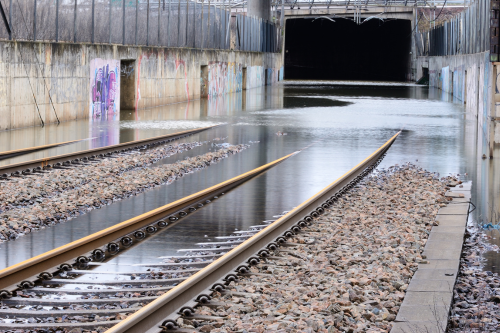The importance of Rail drainage services in the UK

Rail drainage and surface water management are critical components of railway infrastructure, ensuring the safety, efficiency, and longevity of rail networks.
Effective drainage systems are essential for dealing with the water that accumulates on and around the tracks, which can be caused by rainfall, melting snow, or nearby water bodies. Inadequate drainage can lead to a range of problems, from minor inconveniences to severe safety hazards.
Importance of Rail Drainage and Surface Water Solutions
- Track Stability: Water accumulation can undermine the track bed, leading to instability and potential derailments. Effective drainage ensures the track remains stable and safe for trains to operate.
- Preventing Flooding: Flooding can cause significant disruptions to rail services. A well-designed drainage system helps to prevent water from pooling on the tracks and in nearby areas.
- Protecting Infrastructure: Continuous water exposure can damage rails, sleepers, and other infrastructure components, leading to costly repairs and maintenance.
- Safety for Passengers and Staff: Efficient drainage systems contribute to the overall safety of the rail network, protecting passengers and staff from water-related hazards.
Challenges in Rail Drainage
- Varied Terrain: Railways traverse diverse landscapes, each presenting unique drainage challenges. Mountainous regions, urban areas, and coastal zones all require tailored drainage solutions.
- Climate Change and Extreme Weather: Increasingly unpredictable weather patterns and extreme conditions, such as heavy rainfall and flooding, pose significant challenges to existing drainage systems.
- Environmental Considerations: Drainage solutions must be environmentally sustainable, avoiding negative impacts on local ecosystems and water bodies.
- Maintenance and Accessibility: Ensuring that drainage systems are easily accessible for maintenance and are kept clear of debris is crucial for their effectiveness.
Solutions for Effective Rail Drainage
- Ditching and Culverts: Ditches along the sides of the tracks and culverts under them are traditional methods for diverting water away from the rail bed. These need regular maintenance to remain effective.
- Permeable Materials: Using permeable materials in the construction of the track bed can help with water drainage, reducing the amount of water that accumulates on the surface.
- Advanced Drainage Systems: Modern drainage solutions include sophisticated systems that can adapt to varying water levels and flow rates, ensuring effective drainage even during extreme weather conditions.
- Water Management Plans: Developing comprehensive water management plans that consider local geography, climate, and environmental factors is essential for effective long-term drainage solutions.
- Innovative Technologies: Utilising technology such as remote sensing and GIS (Geographic Information Systems) for monitoring and managing drainage systems can enhance efficiency and response times.
- Sustainable Practices: Incorporating sustainable practices, such as creating wetlands or using natural vegetation for water filtration, can improve drainage while benefiting the environment.
Speak to our team about Rail Drainage Services
Effective rail drainage and surface water management are crucial for the safe and efficient operation of railway networks. The challenges posed by varied terrain, extreme weather, and environmental considerations require a combination of traditional methods and innovative solutions.
By investing in advanced drainage systems, adopting sustainable practices, and developing comprehensive water management plans, the rail industry can effectively address these challenges, ensuring the safety and reliability of rail transport for years to come.
To speak to our team about our rail drainage services simply fill in our contact form and we will be in touch as soon as possible.
